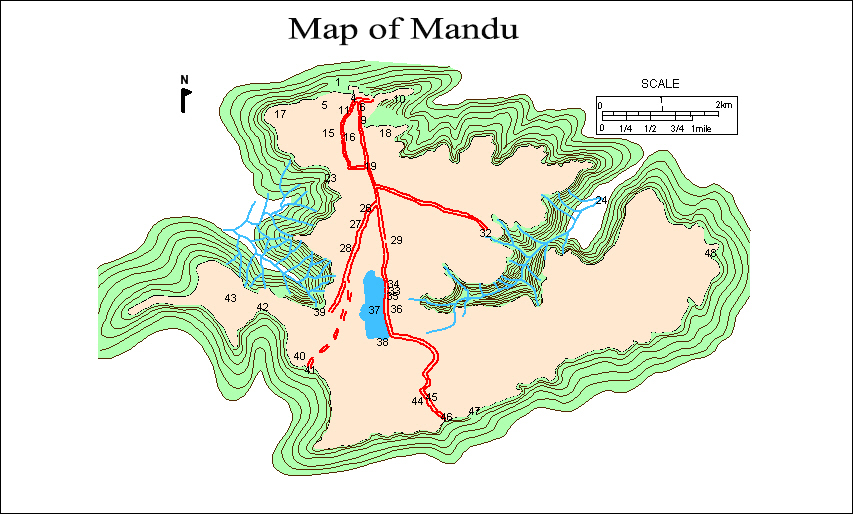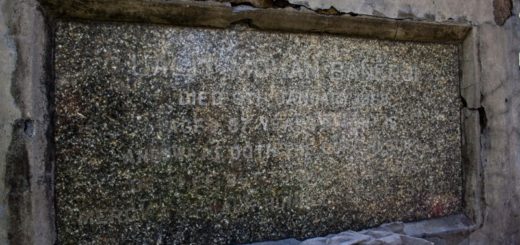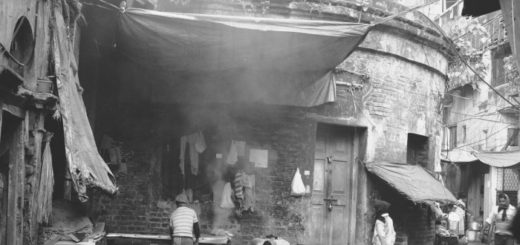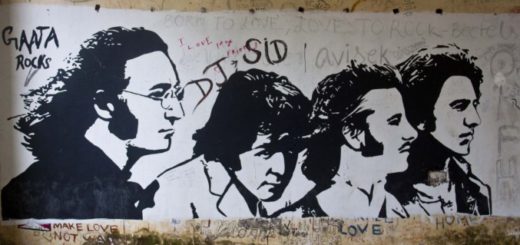
Once, it was a thriving city situated on the top of a hill, surrounded by the dense forest, where nature was the protector of the fort. History was born but lost and drowned with the passage of time. A new history was born again but that also remains silent as time grows. Love bloomed, where Islamic faiths melted into the Hindu faiths, become myths and part of folklore. Music was born, which resonated in the vale and the hills. Even conspiracies were hatched, where a sharp dagger killed the faith of a father. Whatever happened, the destiny never encountered permanent sorrow, as joy was in the air of Mandu. Mandu, a story of a city called Shadiabad or “City of Joy“, Anand Nagri.
It was late evening when our car entered in the horizon of Mandu. We were coming from Hanuwantiya after attending the Jal Mahotsav. It was too dark to see, only gazing at the splendid night sky from the window of my car. It was a beautiful clear night sky, haven’t seen for many years. Aided by the light of the moon and light of our car, I could spot at interval, some gray walls of the fort. They evoked eerie feelings. While passing along the huge walls and crossing the huge gates of the fort, as I felt like, I am heading toward an ancient civilization from the present time, though the time has stopped. I stepped into the hotel room and waited for the sunrise. My eagerness to see the place was condensing like anything. I quickly flipped through the pages of a book on Mandu, and I was stuck. I had read the same book earlier but this time it was completely different reading altogether and my imaginations ran wild. Rani Roopmati, Bazbahadur, Raja Bhoja, Shah Jahan, and even Nur Jahan, those characters were started getting to be alive straight from the pages of a history book. If you are like me who love reading an old history book and love to visualize the perspective narrated. Then, I am pretty sure you would certainly feel being in ancient time. Same happened with me and I couldn’t sleep in that night.
History Of Mandu
The ruined hill fort of Mandavgad or present day Mandu is situated about 35 km away from the Dhar city and 95km from Indore, in the Malwa region of western Madhya Pradesh. The fort is situated on a high plateau nearly 635 m high above the sea level and the road to the fort passes through the dense forest. Sturdy gates were built along the passages for the extra protection. The ramparts of the Mandu fort encompasses approximately 45 sq km and the outer periphery estimated around 75 sq km.
There is a popular saying in central India “Kaha Raja Bhoj aur Kaha Gangu Teli”. Many of us heard of it but never cultivated, who are these people? who were Raja Bhoj and Gangu Teli? This proverb may have originated at Mandu. Was this a comparison between the great king of Telangana Gangaikonda, Rajendra Chola with the very powerful King Bhoja, who was culturally and educationally were very rich. By the end of the 10th century, during the reign of King Bhoja and king Munja, Mandu gained prominence in the history of northern India of that period. But to know the history of Mandu, we need to look back beyond the 10th century. One must understand the historical journey of Mandu. One that began from Madapa-Durga and ended to present day Mandu.
Mandu in earlier days was a very important place for the travelers, pilgrims and for the traders from northern India. Even north Indian traders used this place as a transit point to trade with Europe. Traders used to come here en route Maheshwar, where river Narmada flows the only stream that moves east to west to meet the Arabian Sea. The place therefore gained so much of importance and many powerful kings had their eyes on Mandu. If we minutely watch the Architectures of Mandu, we can understand that how architects and the Kings used this place as an experimental canvas for Architecture. It is said, that Mandu had around 334 palaces, 40 large tanks, 300 mosques and 800 temples, unfortunately, there have no traces many of them. Although, most of the standing monuments were erected in between 1401 AD to 1526 AD, of hardly in 125 years. Islamic rulers like Akbar, Shah Jahan, Jahangir, and even Nur Jahan appreciated the Mandu very much and enjoyed the charm and beauty of its scenery.

Mandu in 6th Century – An inscription discovered from Talanpur in Dhar district, which is dated 555 AD (612 Vikram Sambat) and it states that a merchant named Chandra Simha installed a statue in a temple, located in “Mandapa Durga”. It’s believed that the origin of the Sanskrit name Mandapa Durga derived from Prakrit (one of the many Middle Indo Aryan Languages ) and its vernacular equivalent is Mandava. Even now, this place is called Mandava by the locals of the region. It’s further believed, that the name Mandu has been derived from the corruption of Mandava. Persian histories of the Medieval period also mention Mandava. According to Persian historian Firishta, the early fort of Mandu was built by Anand Deo Rajput of the tribe of Beis in 6th – 7th Century AD. Unfortunately, no trace of the structure survives.
Mandu in 10th Century & Paramaras – According to another inscription 946 AD (1003 Vikram Sambat) discovered from Pratapgadh, Rajasthan, states that Prince Madhava was then a great governor and his Commander-in-Chief Sri-Sarman was taken care of the state at Mandapika, that is Mandu. It seems a part of the fortification was built during the 10th century. But In between 6th century and 9th Century, we hear nothing about this fort. Paramaras rose to power in Malwa region on the verge of the 10th century and during that period this place raising it to an independent kingdom. They first set up their capital at Ujjain and later at Dhar. Malwas attained its height of power, especially under the Kings Munja and Bhoja. Munja-Talao or tank which is within the Royal enclave was made to commemorate King Munja. During the reign of King Bhoja, Mandu was enriched culturally and educationally. An image of Saraswati or Vagdebi has found in Mandu, which was a favorite deity of King Bhoja.
Mandu in 11th to 13th Century – An inscription discovered which is dated 1068 AD (1125 Vikram Sambat) refers to Sri-Bhattaraka-Devendra-Deva, a chief under the Paramara King Udayaditya. It’s likely to be that the Lohani caves were excavated and also Saiva temples were built within the proximity of Mandu or other parts of the hill during that time. Another inscription found in the Fort, which states a long hymn of Lord Vishnu composed by Bilhana. He was the Minister of war under the Paramara King Vindhyavarman, who ruled Malwa at the end of 12th century. During the rule of King Arjunavarman (1210-1218 AD) many temples were erected in the fort under the patronage of Sallekhana, who was the chief in the court of King.
First Muslim ruler to have invaded to Malwa region was Shamsu’d-Din-Iltutmish in 1227 AD and he captured Bhilsa and Ujjain, that time the Paramara King was Devapala. Devapala concluded a treaty and Mandu was left untouched. Paramaras continued to rule Mandu but with as a weakened and shattered power. Jayavarman ruled Mandu from 1256 – 1261 AD. He was succeeded by Jayasimha II who subsequently was defeated and killed in a battle by King Chahamana in 1269 AD. In 1283, Bhoja II came into the power of Malwa and during his time, Jalaluddin Khalji invaded to Malwa in 1293AD and devastated it. Although, Mandu remained under Hindu rulers until 1305 AD.
Mandu in 14th Century – Alauddin Khilji captured Malwa in 1305 AD and with the help of a spy Ayn al-Mulk Multani, who was later appointed as the Governor of Malwa. He secured the access to the fort through a secret route and killed Mahlak Deo. This was when the Hindu kingdom of Malwa was dissolved and the entire region was captured by the Muslim ruler. This was the start of an era, where Hindu and Jain temples of the 10th to 12th century were converted into Mosques. Mosques were erected with the remains of the temples in the hill.
Mandu in 15th Century -During the rule of Muhammad-Bin-Tughluq, Dilawar Khan Ghuri was the Governor of Malwa. In 1401 AD, Dilwara Khan declared himself as an independent ruler of Malwa and kept Dhar as capital. He died in 1405 AD and his son Alp Khan (Hoshang Shah) ascended the throne. He shifted the capital from Dhar to Mandu and he ruled for 27 years. During his period the fortification of Mandu was improved. He showed great taste in architecture. He erected many monuments, palaces, and mosques during his reign. Hoshang Shah died in 1435 AD and his son Ghazani Khan ascended his father’s throne. Ghazani Khan (Mahmud Shah) was poisoned by his own confidante Mahmud Khan and he died in 1436 AD.
This was the end of Ghuri dynasty and Mahmud I became the first Khaji ruler of Mandu. His spirit and passion for wars was much like that of Hoshang Shah. He fought against the rulers of Gujarat, Deccan, Juanpur and even against the Sultan of Delhi. He was always engaged in Military expeditions, with such a spirit, the kingdom of Malwa reached its widest territorial limits. He commemorates his victories over the Rana of Mewar, by erecting a seven storeyed tower and also erected some magnificent structures like his own tomb, Ashrafi Mahal etc. He died in 1469 AD and his eldest son Ghiyasuddin became the ruler. He was a peaceful and religious king. He had a huge addiction for women and never showed interest to engage himself in war. He ruled for 31 years and died in 1500 AD at the age of 80. It is said that he has been poisoned by his son Nasiruddin.
Mandu in 16th Century – Nasiruddin ascended father’s throne in 1501 AD (Not properly referenced, some documents says 1500 AD, some 1501 AD). He was mostly occupied with domestic feuds and unhappily ruled his kingdom for 10 years. After him, his third son Mahmud II ascended the throne. He was also fond of erecting palaces and during his rule, he built a place near Rewa-Kund, which was later known as Baz Bahadur Palace. Important monuments like Gada Shah’s shop, Gada Shah’s Palace and Darya Khan tomb were erected in his reign. Also, engaged with domestic feuds like his father.Bahadur Shah invaded Malwa in 1526 AD and successfully captured the entire region on 28 March 1531. Humayun had two major rivals and one of them was Bahadur Shah of Gujarat. Humayun attacked and conquered Mandu in 1534 AD. As soon as Humayun left Malwa, Mallu Khan assuming the title of Qadir Shah formed the dynasty in 1536 AD.
In 1542 AD Shah Jahan conquered Malwa and appointed Sujjat Khan as governor. He ruled Malwa as an independent ruler and he died in 1554 AD. Afer him, his son Malik Bayazid declared himself as a ruler and ascended his father’s throne with his regal name Baz Bahadur. He was fond of Music and his love for Rupmati distracted him from royal responsibilities. In 1561 AD, Adham Khan, general of Akhbar invaded Malwa and Baz Bahadur fled from the battle. They were about to take Rani Rupmati as a prisoner and instead of falling in their hands, she chooses to commit suicide. The love story of Baz Bahadur and Rani Rupmati is a popular theme in the folklore of Malwa and inseparable from this fort. Mandu lost its importance and glory under the Mughals. But, it was under Mughals, till Aurangzeb’s reign, until captured by the Marathas in 1732 AD by Peshwa Baji Rao.
Rainwater Harvesting System
As I have mentioned earlier, how Architects and the Kings used this place as an experimental canvas for Architecture. Apart from erecting grandeur buildings and monuments, they used the place so technically for rainwater harvesting. The most astonishing fact is, how they made it possible, a few centuries ago. The fort is situated around 635m above the sea level and had no access to ground water. So, they had to be dependent on rainwater. It was a need to develop a system to preserve and proper utilization of rainwater. If we pick up, Jahaz Mahal as an example, we can notice, a beautiful system for storing rainwater. Not only have a provision for harvesting the rainwater but it also provided a cooling system to the entire palace. There are two ponds on the both the sides of the palace named Munj Talao and Kapur Talao. Breeze and evaporation from these two water bodies cooled down the entire building. Basically, the entire fort area had been used scientifically for the storage of rainwater. There are many Baodi, Talao, for the purpose of storing rainwater and there was a system for filtering the rainwater. Almost all the buildings have its own system for preserving rainwater. I think. Mandu is the perfect example of Rainwater Rarvesting.

The archaeological sites of Mandu classified into five groups
A) Central Group
B) Royal Group
C) Rewa Kund Group
D) Darya Khan’s Tomb Group
E) Sagar Talao Group
Apart from these major groups, there are other scattered sites all over the Mandu. There are also several gateways leading to the fortified of Mandu.
F) Other sites or Monuments.
List of Monuments according to Group. I will cover individual group including monuments in separate blog posts.
A) Central Group (Group near the Village of Mandu)
1) Asharfi Mahal
2) Jami Masjid
3) Tomb of Hoshang Shah
4) Tomb of Mahmud Khilji
5) Boria Mahal
B) Royal Group
1) Hindola Mahal
2) Jahaj Mahal
3) Munj Talao
4) Kapoor Talao and the Ruins on it’s Bank
5) Jal Mahal
6) Royal Palace and Champa Baodi
7) Taveli Mahal
8) Nahar Jharoka – Tiger Balcony
9) Dilwara Khan’s Mosque
10) Hathi Pol
11) Gada Shah’s Shop and House
12) Adheri Bawdi
13) Ujawala Bawdi
C) Rewa Kund Group
1) Rani Roopmati Pavilion
2) Baz Bahadur’s Palace
3) Rewa Kund
D) Darya Khan’s Tomb Group
1) Darya Khan’s Tomb
a) Darya Khan’s Tomb
b) Lal Sarai
c) Darya Khan’s Mosque
d) Somvati Kund
e) Kharbuja Mahal
2) Hathi Paga Mahal or Elephant’s leg Palace
3) Roja Ka Makbara
E) Sagar Talao Group
1) Dai ka Mahal
2) Dai ki Chhoti Bahin ka Mahal
3) Malik Mughith’s Mosque
4) Caravan Sarai
5) Jali Mahal (situated on the top of a small mound)
6) Unknown Tomb
F) Other sites or Monuments
1) Lohani Caves and Temple Ruins
2) Delhi Gate
3) Chappan Mahal
4) Nil Kanth Palace
5) Chisti Khan’s Palace
Mandu is a huge city, so it’s understandable how the monuments are scattered in the large area. So, One can see Mandu in a day or two or it could happen that not get enough of it in a week. To extract the essence, the place demand time. Where you should sit and think and can attain a sense of Inner Peace. A place with so much of magnetism, demands a retrospect of the history of the place itself.
I know, I couldn’t spend enough time due to the limitation of time, but I will surely visit Mandu in future.
When to go: Winter and Rainy season. In winter it will be easy for you to explore the place and in the rainy season, the lush greenery will give you eye-popping visual delight. Summer would be pathetic.
Getting there: The nearest railway station and airport are at Indore. Which is around 95 km from Mandu. You have to hire a car from Indore or get there by direct bus. If you are on tight budget, from Indore there are two direct buses to Mandu, the first from Gangwal Bus Stand and second from Sarawate Bus Stand. The journey would take around 4/5 hours. Also, you can opt for break journey by bus. There are regular bus service from Indore to Dhar and take another bus from Dhar for Mandu.
Where to stay: Malwa Retreat and Malwa Resort, which are run by the MP Tourism Department and MP Tourism had arranged our stay there. You can also opt for dorm bed at these hotels. However, there are a lot of other hotel options available in Mandu to suit different budgets.
Malwa Resort – Tel (07292) – 263235,
Email:- mresortm@mptourism.com
Malwa Retreat – Tel (07292) – 263221,
Email:- mretreatm@mptourism.com
Eat and Drink:
a) Baobab juice – The baobab tree, mainly found in Africa. It’s other species also found in Arabian Peninsula, and Australia. Baobab tree found plenty in Mandu. The juice made from its fruits is really a must try. Locally it’s known as “Mandu ke Imli”. Do not buy Baobab fruit for your home but you can buy baobab powder that made from the flesh of the baobab fruit. It’s comes 25/30 Rupees per glass.
b) Dal-Paniya and Dal-Bafla – These are two most famous delicacies of Malwa region.
Getting around:
1) Guides: Abhijit Dhar of MP Tourism had provided us a guide for our tour. Although, guides are available for whole sightseeing and also available in the major locations, on the spot. But I would suggest, request for a guide from MP Tourism Dept.
2) Walk: Walk, Walk and Walk there is no alternative way to explore the sites of Mandu. Have to be covered by foot.
3) Bicycle: Can be hired to visit on the cost of 400/500 Rupees per day.
4) Car: You can hire a car, that would come around 3000/3500 and this is easiest and quickest way to visit.
Booking
Madhya Pradesh State Tourism Development Corporation (MPSTDC)
“Chitrakoot” Building
230-A, A.J.C.Bose Road
Room No – 67, 6th Floor
Kolkata – 700020
Phone No – 033-22875855/ 033-22833526
For Booking Information
www.mptourism.com
www.jalmahotsav.com
Note – My trip to Mandu was a part of a FAM or Familiarization tour.
Special Thanks
Abhijit Dhar, Madhya Pradesh Tourism Development Corporation, Kolkata.
Sumit Surai my fellow FAM participant and friend.
Bodhisatwa Chakraborty, Madhya Pradesh Tourism Development Corporation, Kolkata.
Transport and Support Stuff from MPTDC of Indore and Bhopal Circle.
Mr. Amitava Sengupta – For the edits.
References
1) Mandu – ASI
2) Mandu – A research by Dr. Pushpesh Pant
3) Dhar and Mandu – A Sketch for the Site-Seer By C.E.Luard
4) Dhara Theke Mandu – Debabrata Mukhapadhya
5) Dhar and Mandu – Bombay Subaltern
6) Mandu – A City of Joy by G.Yazdani
7) Imperial Gazetteer of India By James Sutherland Cotton, Sir Richard Burn, Sir William Stevenson Meyer
Copyright © BongBlogger
you can share this post subjects to the conditions that please give due credit to Author Indrajit Das and do not alter before sharing. Request do not Plagiarize.
If you found your photographs here and have issues with that please E-mail me with your requests, I will remove your photographs from public domain.























Wonderful,very well detailed information, nice flow while reading.
Thank you so much
The Place looks wonderful… and nicely captured photos. Keep writing and inspiring!!!
Thank you so much
Very informative post. Beautiful images.
Thank you so much.
It was a walk into the history. WOW, IMAGES. Beautiful and grand – My favorite is Hindola Mahal.
It’s a pity you don’t have a donate button! I’d without
a doubt donate to this excellent blog! I suppose for now i’ll settle
for bookmarking and adding your RSS feed to my Google account.
I look forward to fresh updates and will share this blog with my Facebook group.
Talk soon!
simply superb BongBlogger.. keep it up.
Thank you so much.
Very informative
Where is part 2